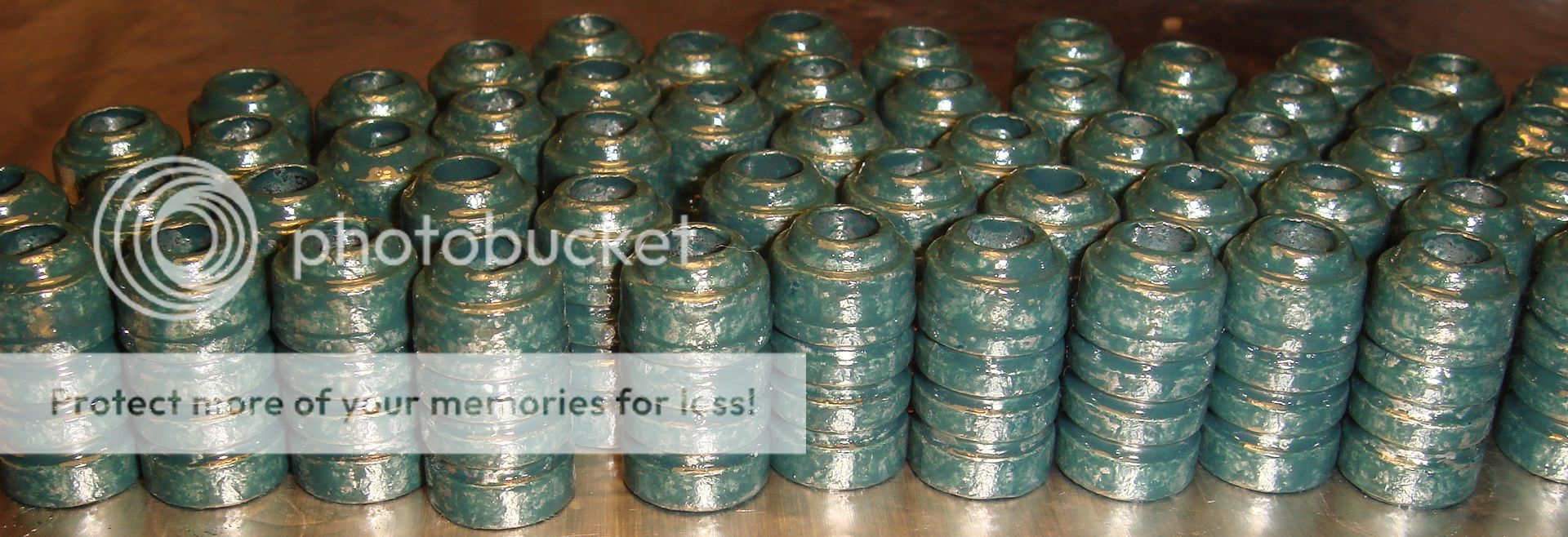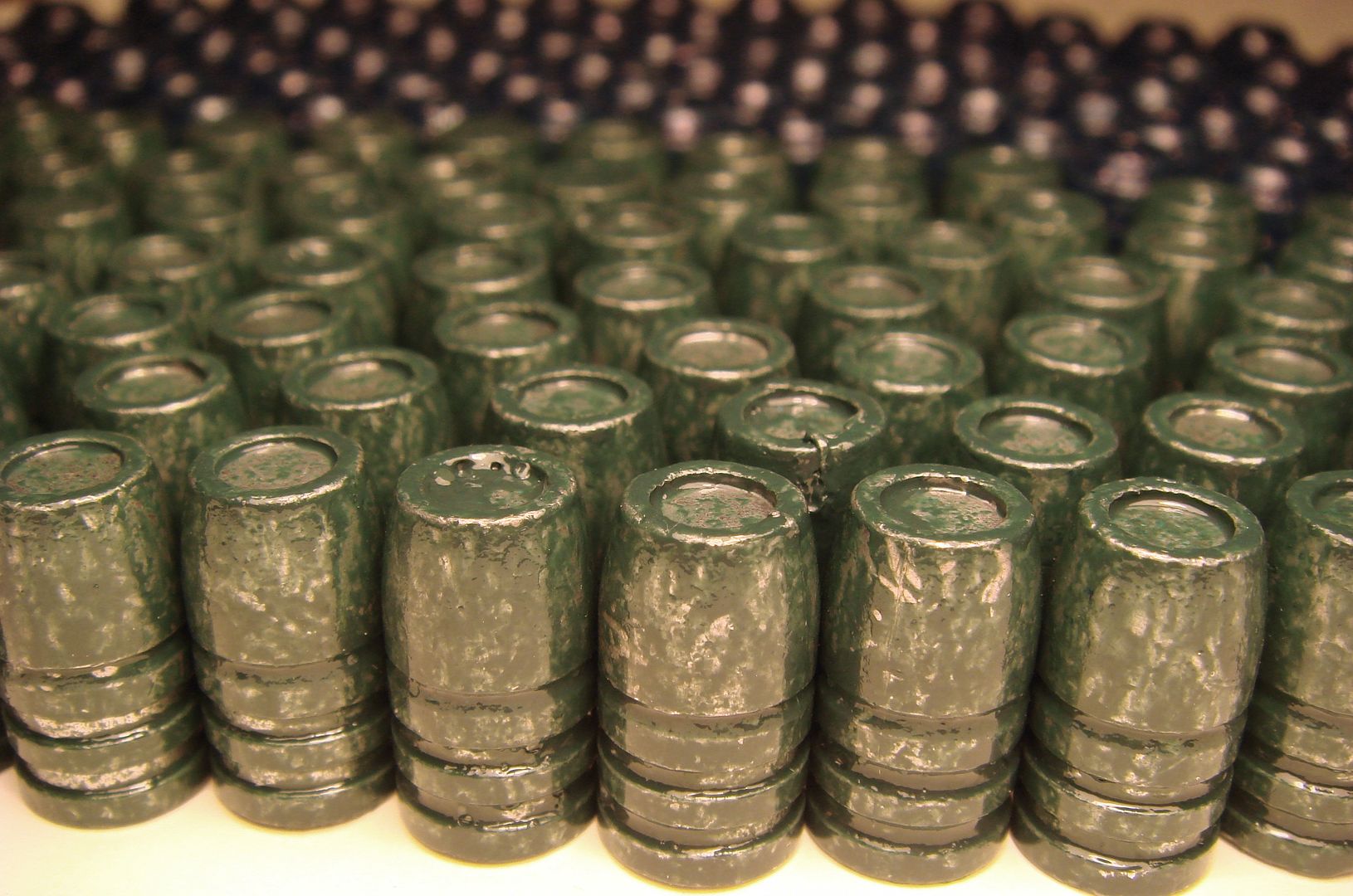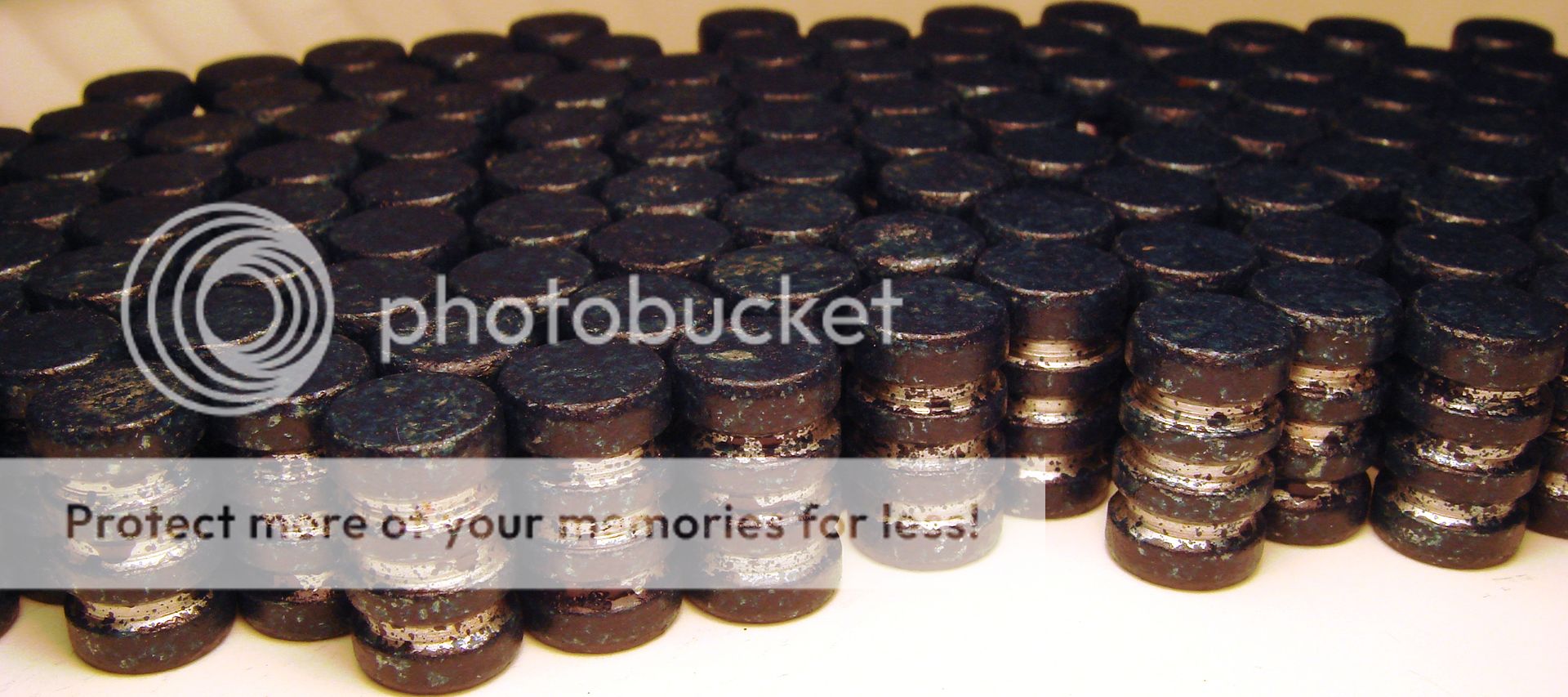You are using an out of date browser. It may not display this or other websites correctly.
You should upgrade or use an alternative browser.
You should upgrade or use an alternative browser.
How much coverage for PC bullets?
- Thread starter Fnusa
- Start date
There are better places to address your issue with powder coated bullets than here.
The following site is likely to produce the result you are looking for if you post your question here: http://castboolits.gunloads.com/forumdisplay.php?184-Coatings-and-Alternatives
Nevertheless, I powder coat and have noticed that some colors (and powders and supplier's powders (avoid Harbor Freight powders)) will flow better than others. The Red I use for some of my cast bullets, does not flow to cover the bullet completely, but does not cause leading. On the other hand, the Sky Blue I use for most of my shooting (.38 Spl., Lee 130 grain .358-RNFP), flows so well when baked that it covers for all purposes, 100%. Therefore, you may want to ask which powders give the most complete coverage, rather than "how much coverage is needed to prevent leading?"
The following site is likely to produce the result you are looking for if you post your question here: http://castboolits.gunloads.com/forumdisplay.php?184-Coatings-and-Alternatives
Nevertheless, I powder coat and have noticed that some colors (and powders and supplier's powders (avoid Harbor Freight powders)) will flow better than others. The Red I use for some of my cast bullets, does not flow to cover the bullet completely, but does not cause leading. On the other hand, the Sky Blue I use for most of my shooting (.38 Spl., Lee 130 grain .358-RNFP), flows so well when baked that it covers for all purposes, 100%. Therefore, you may want to ask which powders give the most complete coverage, rather than "how much coverage is needed to prevent leading?"
Last edited:
armoredman
New member
Smokes' over at Cast boolits is the best I've used. I still use some HF stuff, but that's because it's what I have. I agree with reddog81 - I want good coverage, BUT on the ogive and nose are really just for looks.
I agree with reddog81 - I want good coverage, BUT on the ogive and nose are really just for looks.
A moot point inasmuch as with the "shake and bake" method (or even when using a powder coating gun), you pretty much cannot help covering the ogive and nose.I agree with reddog81 - I want good coverage, BUT on the ogive and nose are really just for looks.
I have also noted that if the bullet alloy is too soft and the velocity is too high, the ogive can become part of the bearing surface. In any event, I prefer to encapsulate the entire bullet when I powder coat so I am not, from that point on, touching bare lead with my hands when I handle the bullets or the loaded rounds.
You want the base and all of the bullet that contacts the chamber throat and rifled barrel covered. The bullet nose isn't as important as the rest.
Myself I like a total job....when I paint my car or my house I paint it all 100% , just looks better that way. Although I have seen houses with just the front painted...no paint on the sided and rear... I don't do it.
Gary
Myself I like a total job....when I paint my car or my house I paint it all 100% , just looks better that way. Although I have seen houses with just the front painted...no paint on the sided and rear... I don't do it.
Gary
armoredman
New member
I use shake and bake myself - I just really don't give a hoot if the nose is covered. But each to their own, and I have fun with mine. As mentioned before, castbullets.gunloads.com is a GREAT resource.
One note that is almost NEVER mentioned in powder coating discussions -
run the powder coated rounds through a sizing die after baking & cooling-
If you don't, the round will frequently be too large to chamber properly.
And it's also a good test of your powder coating - the coating should not crack or flake in the resizing operation.
And a second consideration - the temp of your powder as it burns. A hot powder - like H Titegroup, for example, will burn the powder coating at the butt of the round. I've heard that many PC reloaders favor HP-38 which tends to burn cooler and not damage the PC as much upon firing. I'll be picking up a pound of it soon to test this theory for myself.
run the powder coated rounds through a sizing die after baking & cooling-
If you don't, the round will frequently be too large to chamber properly.
And it's also a good test of your powder coating - the coating should not crack or flake in the resizing operation.
And a second consideration - the temp of your powder as it burns. A hot powder - like H Titegroup, for example, will burn the powder coating at the butt of the round. I've heard that many PC reloaders favor HP-38 which tends to burn cooler and not damage the PC as much upon firing. I'll be picking up a pound of it soon to test this theory for myself.
armoredman
New member
You are absolutely correct - I did not mention that and I do it to every one. As for burning it, have absolutely no evidence one way or another.
chris in va
New member
Powdercoating was a godsend to the casting community, I get ZERO buildup in my barrel.
I source my powder from a local powdercoating shop that refinishes auto parts such as wheels, calipers etc. The blue-ish colors seem to coat the best, not sure why. Yellow and orange are the worst.
My method is simple. Small round plastic storage tub with screw on lid, ~100 9mm dumped in with a tablespoon of powder and black airsoft pellets. Shake for a few seconds, pick them out by hand wearing nitrile gloves and place upright on a flat metal sheet covered with parchment paper, bake at 400 for 20 minutes.
I made two metal sheets so I can bake and place at the same time.
Do you guys have a better method of removing the bullets from the powder?
I source my powder from a local powdercoating shop that refinishes auto parts such as wheels, calipers etc. The blue-ish colors seem to coat the best, not sure why. Yellow and orange are the worst.
My method is simple. Small round plastic storage tub with screw on lid, ~100 9mm dumped in with a tablespoon of powder and black airsoft pellets. Shake for a few seconds, pick them out by hand wearing nitrile gloves and place upright on a flat metal sheet covered with parchment paper, bake at 400 for 20 minutes.
I made two metal sheets so I can bake and place at the same time.
Do you guys have a better method of removing the bullets from the powder?
I use automotive hemostats bent a little bit to hold the round of the bullet a little better. Works well but a tad slow. But then Im more interested in results vs volume.Powdercoating was a godsend to the casting community, I get ZERO buildup in my barrel.
I source my powder from a local powdercoating shop that refinishes auto parts such as wheels, calipers etc. The blue-ish colors seem to coat the best, not sure why. Yellow and orange are the worst.
My method is simple. Small round plastic storage tub with screw on lid, ~100 9mm dumped in with a tablespoon of powder and black airsoft pellets. Shake for a few seconds, pick them out by hand wearing nitrile gloves and place upright on a flat metal sheet covered with parchment paper, bake at 400 for 20 minutes.
I made two metal sheets so I can bake and place at the same time.
Do you guys have a better method of removing the bullets from the powder?
Hemostats are medical devices that are used to clamp blood (hemo), vessels. They are commonly available as surplus. That begs the question: What are automotive hemostats?I use automotive hemostats...
Having used NRA Alox 50/50 for years, I find the thing I like most about powder coating is that it does not produce the mixture of Alox and Carbon that forms an abundant, Black, greasy sludge in my handguns. Powder Coating is so much cleaner to shoot resulting in more shooting before cleaning my guns.Powdercoating was a godsend to the casting community, I get ZERO buildup in my barrel.
chris in va
New member
So you PC over the gas check. Interesting. I have a lot of 180gr 308's given to me but are lubed/gc and would love to put them through my Garand. I may try melting off the lube, PC and see if they work with the gas port.
Melting off the lube will likely leave a residue that will prevent the powder from sticking. I have used Acetone to dissolve the NRA Alox 50/50 and that worked.So you PC over the gas check. Interesting. I have a lot of 180gr 308's given to me but are lubed/gc and would love to put them through my Garand. I may try melting off the lube, PC and see if they work with the gas port.
chris in va
New member
Acetone, thanks. I think these were lubrisized so I may have to use heat as well.
I have boiled the lube off, then swirl twice in gas to get any lube residue off, and then swirl once in acetone to get the gas residue/smell off, and they PC'd great. Do all of that out in the yard though.
Some folks boil with some Dawn and Simple Green in the water and then just swirl in acetone once and claim that works, but I haven't tried that method.
But I always have some aging mower/tiller gas that needed a use anyway.
Some folks boil with some Dawn and Simple Green in the water and then just swirl in acetone once and claim that works, but I haven't tried that method.
But I always have some aging mower/tiller gas that needed a use anyway.
Devices that that are used to clamp oil/gas/vacuum lines. Pretty much same same.Hemostats are medical devices that are used to clamp blood (hemo), vessels. They are commonly available as surplus. That begs the question: What are automotive hemostats?




